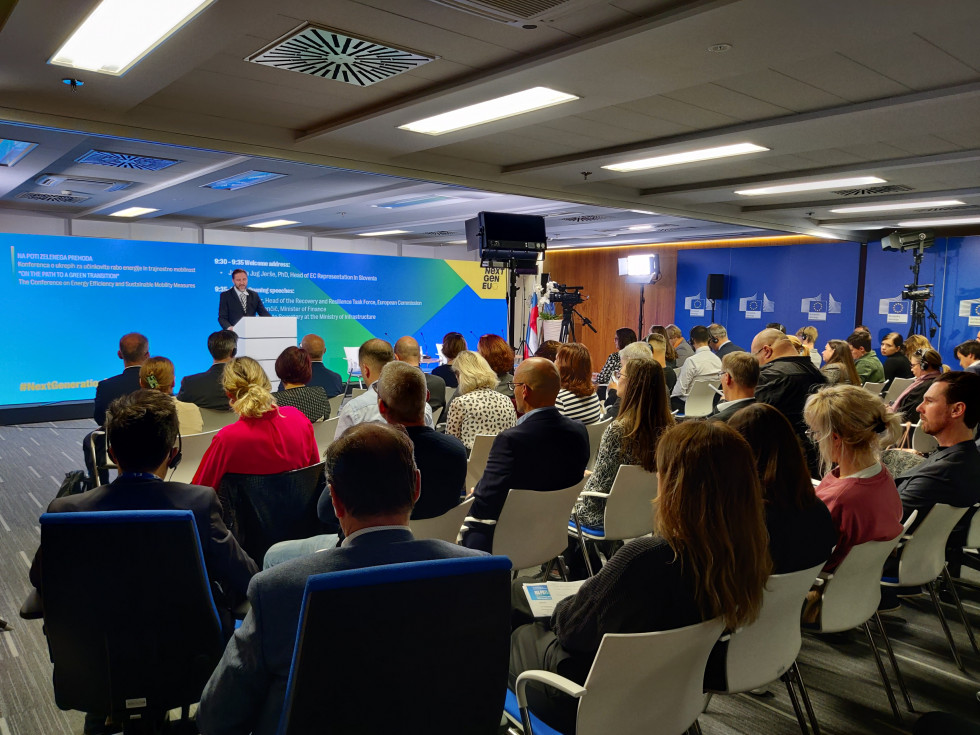On the Road to a Green Transition – at the annual Slovenia’s Recovery and Resilience Plan event
In his opening remarks at the conference, Minister Klemen Boštjančič said Slovenia would be using grants from the Recovery and Resilience Facility worth EUR 1.5 billion to finance the measures in the Recovery and Resilience Plan, and is also planning to use some of the loan money. “Yesterday, Slovenia sent its first application for EUR 57 million to the Recovery and Resilience Facility in Brussels. As we have already received a payment in advance, the final payment will be a little smaller. EUR 156 million has already been invested in projects. Most of this amount has been invested in measures for sustainable mobility aimed at increasing the capacities of railway infrastructure,” he emphasised.
In his speech, the minister also focused on the issue of European funds being paid under the condition that milestones and targets are attained, both in investments and reforms. “We will only be able to draw funds to finance investments if we also implement reforms. Funds from the Facility will not be paid into the state budget until we have reached the milestones and targets agreed with the European Commission. We are facing two of the Slovenian plan’s most demanding reforms – those related to healthcare and pensions – which according to the timeline should be carried out by the end of 2024. Together with all stakeholders, we will have to find solutions for the well-being of all.”
The plan’s measures will contribute to attaining national and European green goals. The minister emphasised that the Slovenian Recovery and Resilience Plan is an opportunity to make ideas for a green future a reality: “It’s important that we use the funds available to us until the end of 2026 wisely and effectively. This is so much more important in a time of higher prices.”
As part of the event, the participants were also able to see progress in the project to upgrade the Ljubljana-Divača railway line – more precisely the completion of works on the Ljubljana-Brezovica section and the beginning of works on the Brezovica-Borovnica section. The participants were addressed by the Minister of Infrastructure Bojan Kumer.
As part of the Recovery and Resilience Plan, the Ministry of Infrastructure will be implementing measures to increase the capacity of railway infrastructure worth just over EUR 284 million. The project involves upgrading 49 kilometres of track and renovating three stations. “The renovation of the section of railway between Ljubljana and Brezovica that we presented today is worth EUR 50 million. The second phase of works on the railway line towards Koper will last until next summer. In order to increase the capacity of its railway infrastructure, Slovenia will also be able to make use of other European funds. It will receive EUR 90 million from the Connecting Europe Facility with which it will modernise eight railway stations in different regions. Almost EUR 57 million will be earmarked for the modernisation of the railway station in Jesenice, and EUR 34 million to scrap level crossings and upgrade railway infrastructure at the stations in Litija, Zagorje, Trbovlje, Laze, Šentjur, Ponikva and Rače. The aim of the project is to achieve greater traffic flow, faster travel, and a higher standard of rail travel,” explained Minister Kumer.
The Head of the Recovery and Resilience Task Force at the European Commission, Céline Gauer, stressed that investments in railway infrastructure were among the most important in the Recovery and Resilience Plan. Investments and reforms in the management of passenger transport will contribute to providing faster, more comfortable and more sustainable travel.
Introductory words were also contributed by the director of the coordinating body of the Recovery and Resilience Office, Josip Mihalic. “By filing the first application and holding the first annual event, we have reached an important milestone in the process of implementing the Slovenian Recovery and Resilience Plan. A period of full-scale investment and reform is beginning. Much work awaits us. But we are going ahead at full steam,” he concluded.


